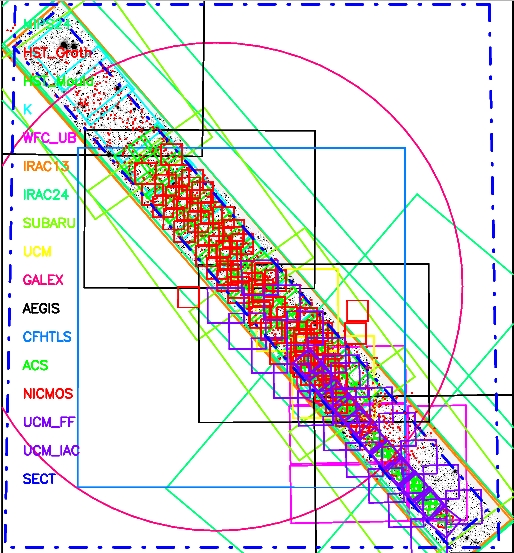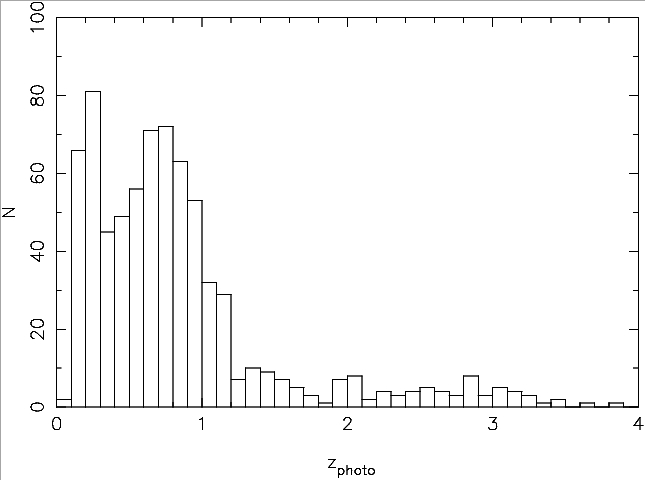The UCM/EGS Group
This work
has been carried out with the collaboration of
the following people from the UCM Star Formation
Group: Pablo
G. Pérez-González, Guillermo
Barro, Víctor Villar, Jesús
Gallego, and Jaime Zamorano.
Covered area

This figure shows the footprints of all
the data that the UCM Database have
compiled in the EGS region. The background
shows the IRAC-3.6 micron image, with all
the other datasets overimposed on it in
different colors (see below for a list of
bands). Red small circles show the
positions of the FIDEL sources.
Merged data
The data compiled in the UCM Database include:
1) IRAC images (3.6, 4.5, 5.8, and 8.0 micron).
2) MIPS images (24 micron).
3) HST/WFPC2 (PI-Groth) images in the original Groth Strip (F606W, F814W).
4) HST/WFPC2 (PI-Mould) images near the original Groth Strip (F606W).
5) Subaru R image covering the whole strip.
6) CFHTLS ugriz images covering the central area of the strip.
7) CFHT-12k BRI data covering the whole strip (some artifact problems to be solved).
8) UCM JK images of half of the strip.
9) ACS vi images of half of the strip.
10) NICMOS F110W and F160W of half of the strip.
11) J and K Palomar catalogs.
12) GALEX data of the central part of the strip.
13) DEEP2 DR3 spectroscopy.
Comparison between photo-z and spec-z
Spectral energy distributions have
been built for all FIDEL sources (where
other data are available) following the
same procedure explained in Pérez-González
et al. (2007, ApJ, in press)
These SEDs have been used to estimate
photometric redshifts by comparing them to
templates built with stellar and dust
emission models (see Pérez-González
et al. 2007). The following figure
shows the comparison of spectroscopic and
photometric redshifts for the FIDEL
sources with available spectroscopy in the
DEEP2 DR3. The quality of the photo-z's is
very good (i.e., Δ(z)/(1+z)<0.1) for
88% of the sources (only considering the
267 FIDEL sources with spec-z and a
quality flag larger or equal to 3), and
acceptable (i.e., Δ(z)/(1+z)<0.2)
for 97%.

In the figure below, we show the
photo-z distribution of the FIDEL
sources. 77% of all galaxies with a
photo-z (729 galaxies) lie at z<1, and 88%
at z<1.5. There are around 30 sources from
your original catalog for which I was not
able to obtain a photo-z because there
were not enough data points in their SEDs.

Accesing photo-z's
You can find all the photo-z's in the
following
file. The first field in each row
shows the FIDEL source ID, the second
field shows the best photo-z estimation,
and the eightth and nineth fields show the
spec-z and corresponding flag. Sources
whose names end with a suffix like "_1",
"_2", etc... are galaxies where multiple
identifications were found within the
search radius (2.5"), and a deblending
algorithm was called (see Pérez-González
et al. 2007)
Please, note that the number of data
points in the SEDs vary from source to
source due to differences in the
availability and depth of ancillary
data. This means that the most reliable
photo-z's correspond to sources within the
IRAC strip, where other UV/optical/NIR/MIR
data are also available. The sources
outside this area are not as reliable.
We have also produced another
alternative photometric catalog where we
have measured the photometry in small
(around 2" diameter) apertures, and
applied an aperture corrections to recover
total fluxes. This catalog may be better
for very faint, almost point-like sources,
as the flux measurements may be less
noisy. You can find all the photo-z's
obtained with this photometric catalog in
the following
file, with the same format described
above.
Accessing SED plots
If you want to take a look at the SEDs,
postage stamps of the source in every band
where data are available, the photometric
aperture, and some general information for
individual sources, you can use this php
interface. You will need the username
and password: fidel/fidelcigars. Just
select the photometric catalog (the main
one is FIDEL and the alternative is
FIDEL_k04), write the coordinates or the
FIDEL name of your source (e.g.,
fidelegs70_0000286) and hit submit. Note
that some sources have a "_#" suffix and
you must provide it to access the SED
information. Once in the source webpage,
you can click on "set cuts" for any image
to play with the size and cuts of the
postage stamp.